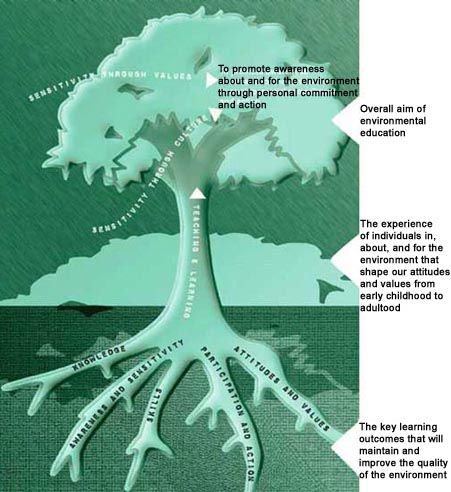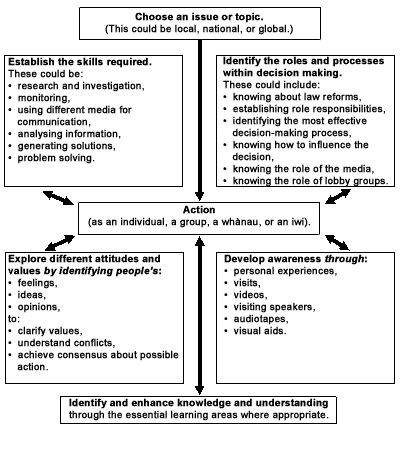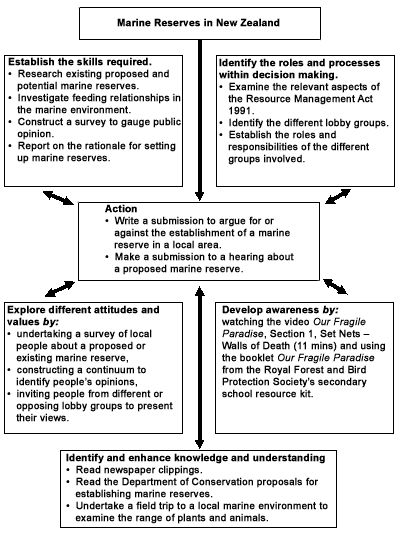Department of Conservation. Greenprint Overview: The State of Conservation in New Zealand. Wellington: Department of Conservation, 1993.
Department of Conservation. New Zealand's Biodiversity: An Overview. Wellington: Department of Conservation, 1994.
Fien, J. and A. Greenall Gough. "Environmental Education" in Gilbert, R. (Ed.) Studying Society and Environment: A Handbook for Teachers. South Yarra: MacMillan Education Australia, 1996.
Fien, J., D. Heck, and J. Fereira. Learning for a Sustainable Environment: A Professional Development Guide for Teachers. Brisbane: UNESCO Principal Regional Office for Asia and the Pacific, Bangkok and Griffith University, 1997.
Fien, J. (Ed.) Environmental Education: A Pathway to Sustainability. Geelong: Deakin University Press, 1993.
Hails, Christopher. The Importance of Biological Diversity. Switzerland: World Wide Fund (WWF–International), 1989.
Keating, M. The Earth Summit's Agenda for Change: A Plain Language Version of Agenda 21 and the Other Rio Agreements. Geneva: Centre for Our Common Future, 1993.
Ministry for the Environment. Environmental Education Directory New Zealand. Wellington: Ministry for the Environment, 1999.
Ministry for the Environment. Environment 2010 Strategy: A Statement of the Government's Strategy on the Environment. Wellington: Ministry for the Environment, 1995.
Ministry for the Environment. Forging the Links: New Zealand's National Report to United Nations Conference on Environment and Development (UNCED). Wellington: Ministry for the Environment and Ministry of External Relations and Trade, 1992.
Ministry for the Environment. Learning to Care for Our Environment: Me Ako ki te Tiaki Taiao: A National Strategy for Environmental Education. Wellington: Ministry for the Environment, 1998.
Ministry for the Environment and the New Zealand Local Government Association Inc.Taking Up the Challenge of Agenda 21: A Guide for Local Government. Wellington: Ministry for the Environment, 1994.
Ministry of Education. Anywhere, Everywhere: EOTC Curriculum Guidelines for Primary Schools, Secondary Schools, and Early Childhood Centres. Wellington: Learning Media, 1992.
Ministry of Education. Education for the 21st Century. Wellington: Learning Media, 1994.
Ministry of Education. English in the New Zealand Curriculum. Wellington: Learning Media, 1994.
Ministry of Education. Health and Physical Education in the New Zealand Curriculum. Wellington: Learning Media, 1999.
Ministry of Education. Mathematics in the New Zealand Curriculum. Wellington: Learning Media, 1992.
Ministry of Education. Science in the New Zealand Curriculum. Wellington: Learning Media, 1993.
Ministry of Education. Social Studies in the New Zealand Curriculum. Wellington: Learning Media, 1997.
Ministry of Education. Technology in the New Zealand Curriculum. Wellington: Learning Media, 1995.
Ministry of Education. The Arts in the New Zealand Curriculum: Draft. Wellington: Learning Media, 1999.
Ministry of Education. The New Zealand Curriculum Framework. Wellington: Learning Media, 1993.
Ministry of Foreign Affairs and Trade. Convention on Biological Diversity: Third Conference of the Parties, Buenos Aires, Argentina, 4 to 15 November, 1996: New Zealand Delegation Report. Wellington: Ministry of Foreign Affairs and Trade, 1996.
Ministry of Māori Affairs Natural Resource Unit. Māori Values and Environmental Management. Wellington: Manatu Māori, 1991.
New Zealand Government. The Resource Management Act 1991. Wellington: New Zealand Government, 1991.
New Zealand Government. Treaty of Waitangi, 6 February, 1840. Wellington: National Archives.
Te Puni Kokiri. Mana Tangata: Draft Declaration on the Rights of Indigenous Peoples 1993: Background and Discussion on Key Issues. Wellington: Te Puni Kōkiri, 1994.
The Royal Forest and Bird Protection Society Inc. Our Fragile Paradise: An Activity-based Secondary School Resource Kit (video and booklet). Wellington: The Royal Forest and Bird Protection Society Inc., 1994.
UNESCO Asia-Pacific Regional International Experts' Meeting. Overcoming the Barriers to the Successful Implementation of Environmental Education through Teacher Education. Brisbane: Griffith University, 1993.
UNESCO–UNEP. "The Tbilisi Declaration." Connect, Vol. III (1), 1978, pp.1–8.
United Nations Conference on Environment and Development (UNCED). The Earth Summit. Rio de Janerio: United Nations Conference on Environment and Development (UNCED), 1992.
United Nations Education, Scientific, and Cultural Organisation (UNESCO). Final Report: First Intergovernmental Conference on Environmental Education. Paris: UNESCO, 1978.
World Commission on Environment and Development. Our Common Future. New York: Oxford University Press, 1987.
World Health Organisation. The Ottawa Charter for Health Promotion. Ottawa: World Health Organisation, 1986.
World Resources Institute (WRI), International Union for Conservation of Nature and Natural Resources (IUCN), United Nations Environment Programme (UNEP), Food and Agriculture Organisation of the United Nations (FAO), and the United Nations Education, Scientific, and Cultural Organisation (UNESCO). Global Biodiversity Strategy: Guidelines for Action to Save, Study, and Use Earth's Biotic Wealth Sustainably and Equitably. Washington: World Resources Institute, 1992.



